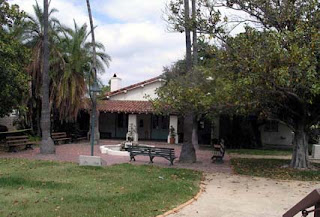North on 101 for 3.3 miles to
Ah, memories of earlier days in the music business at the mention of Lankershim Blvd; the Palomino Club, Nudie’s Rodeo Tailors, The Sportsman’s Lodge…but we’re here in the shadows of Universal City to the site where 110 years prior to Nudie Cohn stitching up Elvis’ gold lame suit, the Mexican Army capitulated and made an agreement with American forces to stop shooting at each other while a treaty was put together.
1976 photo
To describe the details of that agreement it’s best to leave it to Warrant Officer 1 Mark J. Denger representing the
“At the site of an abandoned adobe ranch-house, Lieutenant Colonel John C. Frémont signed a treaty, generally termed the "Capitulation of Cahuenga," with General Andres Pico of
Campo de Cahuenga was once a part of Rancho Verdugo, occupied by Mariano de la Luz Verdugo. In 1810 the San Fernando Mission had taken over Rancho Partezuela, the Verdugo ranch, and had dammed up the
In January of 1847, the last two serious military engagements against
It was on January 11, 1847, a few miles above
Detained there, Pico informed the leading officers of the army of Frémont's arrival and the number of his men. With the combined forces of Frémont and Stockton, now in
General Flores, who had been appointed by the territorial assembly governor and comandante-general, had taken his departure for
General Pico, on assuming command, appointed Francisco Rico and Francisco de La Guerra to confer with Col. Frémont.
Meanwhile, Frémont appointed Major P. B. Reading, Major William H. Russell and Captain Louis McLane as commissioners to negotiate a treaty. Gen. Pico, in turn, appointed Jose A. Carrillo, commander of the cavalry squadron, and Augustin Olvera, disputaso of the assembly, and moved his army near the
The commissioners met in the deserted ranch-house of Tomas Feliz (Campo de Cahuenga), and a treaty was drawn up.
The principal conditions of the treaty of "Capitulation of Cahuenga," as it was termed, were that the Californians, on delivering up their artillery and public arms, and promising not to again take up arms during the war, and conforming to the laws and regulations of the
The terms being mutually acceptable to both Colonel Frémont and General Andres Pico, it was signed. An additional section was added to the treaty on the 16th at
In accordance with the terms of the treaty, two cannon were surrendered, the howitzer captured from Gen. Kerny at San Pasqual, and the "Old Woman's Gun" that won the battle of Dominguez Ranch.
On January 14, Frémont marched his battalion through the
In a little more than six months, U.S. naval forces of the Pacific Squadron, aided by the California Battalion, two companies of dragoons, and the Morman Battalion, had seized and pacified the whole area that is, today, the state of California.
To Frémont's credit, the treaty of Campo de Cahuenga (shown below) brought peace with honor, allowing both nationalities in
According to their webpage, the site is currently closed for renovations, as it was in 2009, but will be open soon.
Plaque inscription: NO. 151
GPS 34.139759,-118.361973





No comments:
Post a Comment